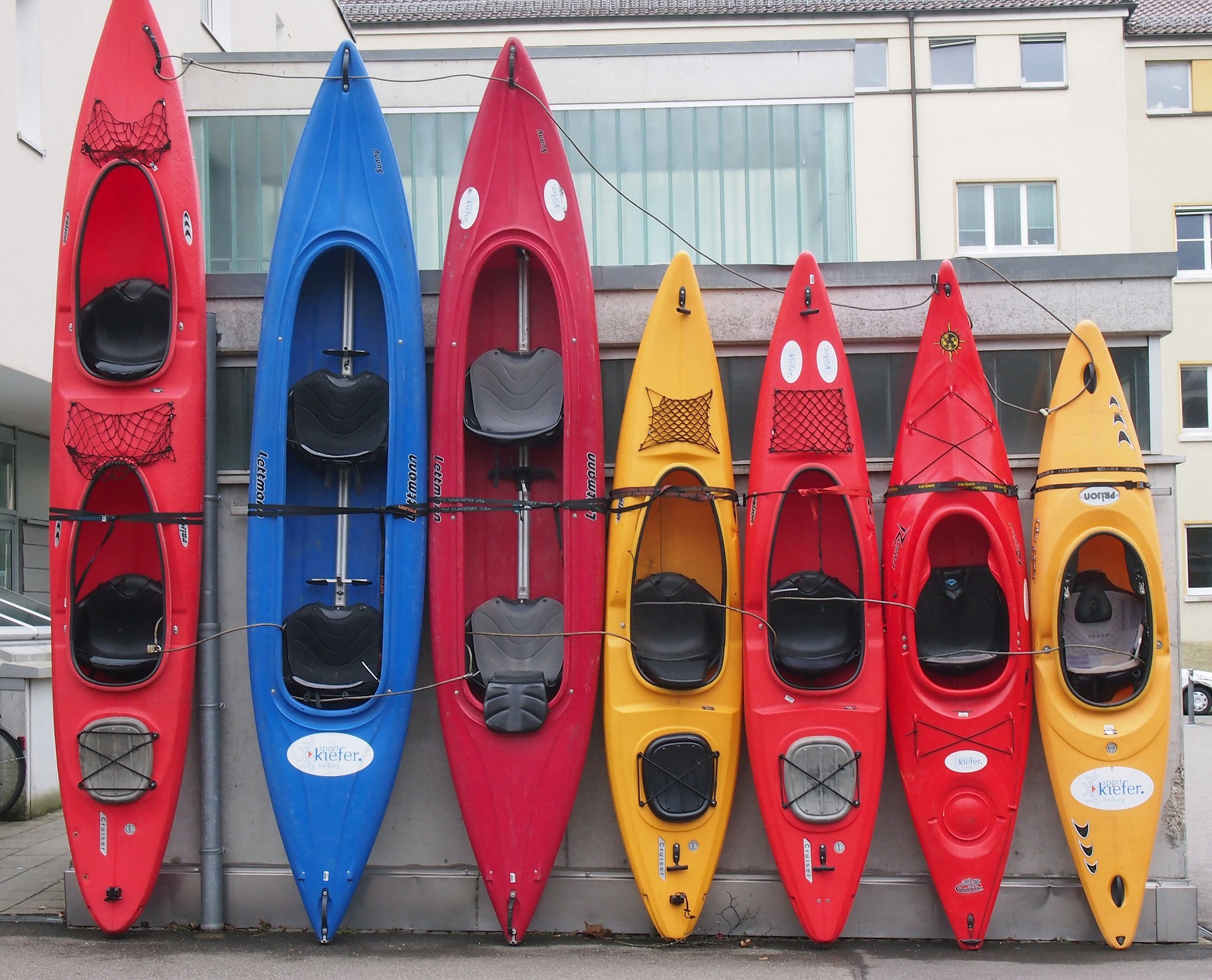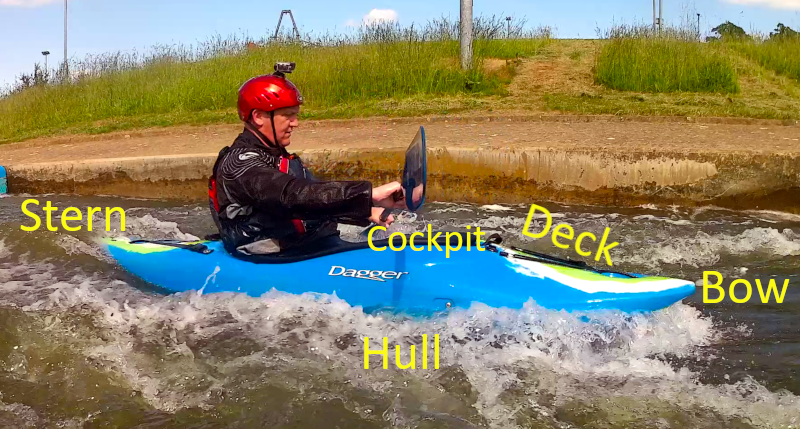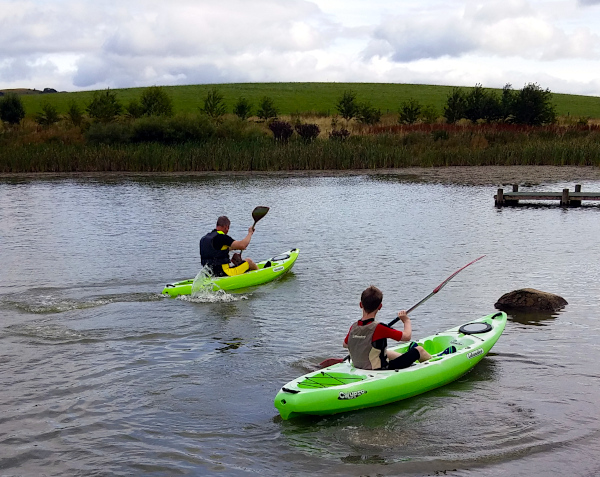Choosing A Kayak - 9 Steps To Ensure You Make The Perfect Purchase
Choosing a kayak is a very important step for you.
Get it wrong and you will find it really difficult to progress, much harder work and definitely less fun.
The steps given below will help you in choosing a kayak that suits your needs best.
Some of the steps you may be familiar with - and that's ok. Other steps may be new to you and can help you to choose the right kayak.
Let's find out more...
 A range of kayaks - single and doubles
A range of kayaks - single and doublesStep 1 - Decide what your kayak is for
There are many disciplines in kayaking - white water, touring, slalom, sea, polo, racing - to name some.
It helps to have a vision on which of these you would like to focus on. If you are starting out in kayaking, you probably don't know any of the disciplines or even have tried any. In this instance, it would be wise for you to:
1) Try out some different kayaks. You can do this at a local club or water sports activity centre. Try as many as you can and get a feel for which you like best.
2) Check out any online videos for each discipline. There are many and you will enjoy seeing how the kayaks are used.
3) Read books about the disciplines. Not just specific books, but also autobiographies of people within the disciplines. You'll be amazed at the insight these will give you.
Step 2 - Understand the basic kayak terms

It's useful to know these basic terms so you can begin to describe a kayak and to understand how these elements fit in with the kayak dynamics.
Step 3 - Understand the dynamics of a kayak
Kayaks are not just lumps of plastic or fibreglass. They are carefully crafted and engineered to act in certain ways on the water.
It's useful to understand the basics (and these really are the basics!).
The width of the kayak determines the stability. The wider the kayak, generally the less tippy it will be.
The narrower the kayak, the more unstable it will be - especially when stationary in the water. However, narrow kayaks can be easier to roll (see this link for more information about kayak rolls - How To Screw Roll
The length of the kayak determines how easy the kayak is to turn. The longer the kayak, generally the harder it is to turn.
The shorter the kayak, the easier it is to turn.
The height of the kayak from the water and the hull shape affects both the stability and manoeuvrability of the kayak.
As you are paddling a kayak, all of these dynamics are acting on the kayak to make it perform in the way it does.
Step 4 - Try, try and then ... try some more
The best way of finding out if a kayak suits you is to try it out yourself.
You should never purchase a kayak (new or second hand) without trying it out. How it performs with your build, weight and paddling style will give you a clear idea of whether it works for you.
And - ensure you try your kayak in it's natural environment. A white water kayak should be paddled on at least moving water - ideally white water.
A touring kayak should be paddled on a short trip (more than a mile) and loaded with a small amount of kit too.
You can try (or hire) kayaks at most kayaking shops, local clubs and other water sports activity centres. Here's a video of Maisie and I trying out a double sit on top kayak:
If you are buying a new kayak - read Step 5a.
If you buying a second hand kayak - read Step 5b.
Step 5a - Find a supplier (shop or online retailer) to purchase from when buying new
There are so many choices for purchasing kayaks. The internet is a great resource to discover local shops and suppliers. Try searching on 'kayak shops near me'.
Going wider a field is useful too as stock and prices may differ. Even factoring in the extra travel costs you can still grab you a bargain.
Step 5b - Find a buyer to purchase from when buying second hand
When purchasing second hand, you can often get a bargain - and it feels good to be giving an unneeded item a new lease of life.
However, it does come with risks.
Prices may vary wildly and may not reflect the condition of the kayak you are purchasing. Always visit the buyer and inspect the kayak yourself.
Some basic inspections you must do:
- Is the kayak water tight? Perform a visual check and a water tight test too.
- Are there any dents, creases or scratches that will become splits or holes?
- Are all the fitting (footrests, buoyancy foam, toggles, straps. skegs etc) in tact and working?
- Is the kayak old? Any kayak that is more than, say, 10 years old may have deteriorated and the material (plastic/fibreglass) may be weak.
- Does the kayak belong to the person selling it? Obvious, but scammers sometimes will sell other peoples kayaks - with or without their permission!
- Does the price of kayak reflect the condition? You only have one chance at buying it so if you overpay, you will not be able to get the money back.
Always pay using bank transfer or credit card. Using cash is untraceable and won't give you any protection should things go wrong.
And the number 1 rule - if in doubt, walk away. There will always be another chance - despite what the seller might say!
Step 6 - Get someone else's view
Whether you are buying new or second hand, you should read as many reviews (of the kayak and the seller) as possible.
Social media sites are a great place to start. Other people will be quick to help you and tell you what they think.
Specialist review sites such as Feefo or Trustpilot are third party companies and will give an impartial view from their reviewers.
As you gain more information, don't be afraid to change your mind. There may be pressures on you to move forward, but if you unsure it's best to stop, take a break, and come back to it.
Step 7 - Make the purchase
Making the decision to purchase and completing the transaction is super important to get right.
If you are ordering online via a website (and shopping cart), make sure you have selected the correct options (colour, size, fitting etc) before you confirm and pay.
You could call the customer care line/chat to ask any questions or clarify any options you need.
Take note of any delivery options (dates) and charges (these will be added on to the price of the kayak).
Buying in a shop is a little more tricky as you will have to do your selection and inspection quickly at the point of purchase. However, do take your time and don't be rushed by the sales person.
Add on any extra equipment you may need (paddle, buoyancy aid etc) and read through your shopping cart before you pay.
Paying via a credit card (online or in the shop) is useful as it gives you extra security. Online shopping does give your extra consumer rights protection such as this: Cooling Off Period
Ask for a discount! It's likely that the kayak will be a high price so it is wise to ask for a discount - whether buying new or second hand. Even a 5% discount is worth having!
Step 8 - Collection/Delivery
Once the purchase is complete, you can arrange collection/delivery.
Be clear with the seller what is included in the sale (ideally get this in writing) and what date the collection/delivery is.
If the kayak is being delivered, get a tracking number so you can keep an eye on the delivery and chase up if it is late or does not arrive at all.
If you are collecting the kayak, take your time to inspect the kayak and ensure it is the exact one that you ordered and includes everything that was included in the sale. Anything that is wrong must be rectified before you accept the kayak.
Step 8 - Initial Inspection
Once you have the kayak perform a thorough initial inspection.
This should include a close look at the kayak, the fittings and any accessories that came with it.
Even minor imperfections can become bigger problems later on so don't be afraid to contact the seller for clarification on anything that is wrong.
A decent seller will expect this and be delighted to help. After all, they want you to be a happy customer!
For identification/insurance purposes, take a handful of photos of the kayak, fittings and accessories. This is useful too in case anything breaks/fails later on.
Step 9 - Enjoy your new kayak
Now you have your new kayak - enjoy it!
It's amazing the freedom owning your own kayak gives you.

PS. Paddlesports can be dangerous.
Read our safety disclaimer - here

New paddling inspiration, tip, trip or technique video EVERY week! Watch Ed, Dave and Moo on their kayaking, canoe and SUP adventures. It's all about safely having fun on the water. 200,000+ views, 110+ videos & 900+ subscribers so far! Click below to start watching:
Ed & Dave Kayaking Youtube Channel
WANT TO HELP US?
We really value your visit to us today. We run this website and our Youtube channel to provide paddling inspiration, tips, trip and technique content to you. We love being out on the water! If you enjoyed your visit, you can support us by using the links below:
Buy us something on our wish list
Thank you
NEED WEB HOSTING?
We recommend IONOS. Great service, technical support and stable hosting. Click the link below to find out more:
IONOS Web Hosting - RECOMMENDED!



